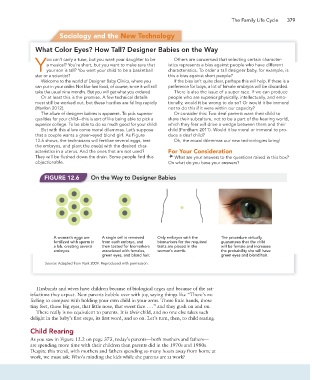Page 406 - Essencials of Sociology
P. 406
The Family Life Cycle 379
Sociology and the New Technology
What Color Eyes? How Tall? Designer Babies on the Way
ou can’t carry a tune, but you want your daughter to be Others are concerned that selecting certain character-
a musical? You’re short, but you want to make sure that istics represents a bias against people who have different
Yyour son is tall? You want your child to be a basketball characteristics. To order a tall designer baby, for example, is
star or a scientist? this a bias against short people?
Welcome to the world of Designer Baby Clinics, where you If the bias isn’t quite clear, perhaps this will help. If there is a
can put in your order. Not like fast food, of course, since it will still preference for boys, a lot of female embryos will be discarded.
take the usual nine months. But you will get what you ordered. There is also the issue of a super race. If we can produce
Or at least this is the promise. A few technical details people who are superior physically, intellectually, and emo-
must still be worked out, but these hurdles are falling rapidly tionally, would it be wrong to do so? Or would it be immoral
(Hanlon 2012). not to do this if it were within our capacity?
The allure of designer babies is apparent. To pick superior Or consider this: Two deaf parents want their child to
qualities for your child—this is sort of like being able to pick a share their subculture, not to be a part of the hearing world,
superior college. To be able to do so much good for your child! which they fear will drive a wedge between them and their
But with this allure come moral dilemmas. Let’s suppose child (Fordham 2011). Would it be moral or immoral to pro-
that a couple wants a green-eyed blond girl. As Figure duce a deaf child?
12.6 shows, the technicians will fertilize several eggs, test Oh, the moral dilemmas our new technologies bring!
the embryos, and plant the one(s) with the desired char-
acteristics in a uterus. And the ones that are not used? For Your Consideration
They will be flushed down the drain. Some people find this ↑ What are your answers to the questions raised in this box?
objectionable. On what do you base your answers?
FIGURE 12.6 On the Way to Designer Babies
A woman’s eggs are A single cell is removed Only embryos with the The procedure virtually
fertilized with sperm in from each embryo, and biomarkers for the required guarantees that the child
a lab, creating several then tested for biomarkers traits are placed in the will be female and increases
embryos. associated with females, woman’s womb. the probability she will have
green eyes, and blond hair. green eyes and blond hair.
Source: Adapted from Naik 2009. Reproduced with permission.
Husbands and wives have children because of biological urges and because of the sat-
isfactions they expect. New parents bubble over with joy, saying things like “There’s no
feeling to compare with holding your own child in your arms. Those little hands, those
tiny feet, those big eyes, that little nose, that sweet face . . .” and they gush on and on.
There really is no equivalent to parents. It is their child, and no one else takes such
delight in the baby’s first steps, its first word, and so on. Let’s turn, then, to child rearing.
Child Rearing
As you saw in Figure 12.2 on page 373, today’s parents—both mothers and fathers—
are spending more time with their children than parents did in the 1970s and 1980s.
Despite this trend, with mothers and fathers spending so many hours away from home at
work, we must ask: Who’s minding the kids while the parents are at work?

